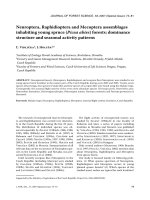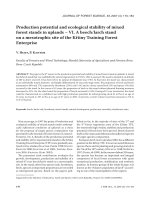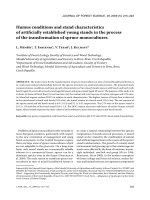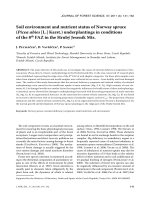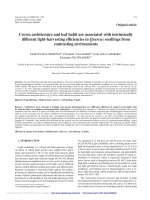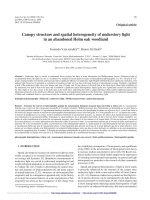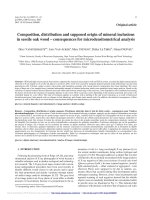Báo cáo lâm nghiệp: "Hybridization techniques and frost tolerance studies in intraspecific hybrids of Eucalyptus globulus Labil" pdf
Bạn đang xem bản rút gọn của tài liệu. Xem và tải ngay bản đầy đủ của tài liệu tại đây (90.69 KB, 2 trang )
Hybridization
techniques
and
frost
tolerance
studies
in
intraspecific
hybrids
of
Eucalyptus
globulus
Labill
M.H.
Almeida
1
A.C.
Leal
2
1
Instituto
Superior
de
Agronomia,
Forestry
Dept.,
Lisbon,
and
2
CELBI
(Celulose
Beira
Industrial),
Quinta
do
Furadouro,
Obidos,
Portugal
Introduction
Hybridization
techniques
have
been
de-
veloped
since
1985,
in
a
clonal
seed
orchard
of
E.
globulus
located
in
the
central
coastal
area
of
Portugal.
The
objective
was
to
enlarge
the
genetic
base
of
the
E.
globulus
population.
In
intra-
specific
hybrids,
seed
characteristics
and
growth
were
evaluated
in
the
field
and
frost
tolerance
studies
were
made
in
a
temperature-controlled
chamber.
Materials
and
Methods
Controlled
pollination
Controlled
pollination
techniques
were
devel-
oped
in
grafted
material
in
3
clones
(27
trees).
A
total
of
2327
flowers
were
pollinated.
At
anthesis,
the
operculum
was
removed
manually
and
emasculation
was
done
with
a
blade.
The
flowers
were
then
isolated
with
unwoven
teryle-
ne
bags.
Optimum
stigma
receptivity,
shown
by
an
exudate,
was
determined
using
controlled
pollinations
made
over
2
d
intervals,
from
d
4
to
d
14,
in
groups
of
60
flowers.
In
each
group,
the
proportion
of
flowers
with
stigmatic
exudations
was
recorded.
Controlled
pollinations
were
made
with
a
brush.
Seed
production,
rate
of
germination
and
sur-
vival
of
seedlings
were
evaluated
in
cross-,
self-
and
open-pollinated
flowers,
using
100
seeds
from
20
capsules
per
seed
type.
Some
of
these
seeds
were
planted
in
the
field
and
evaluated
for
growth.
Frost
folerance
Twelve
uniform
:;eedlings
from
each
of
3
full-sib
families
were
subjected
to
8
h
of
light
at
close
to
25°C
outdoor/1
h
of
dark
at
4°C
in
a
cold
room.
A
second
comparable
group
of
seedlings
remained
outdoors
under
favorable
growth
conditions
and
after
3
wk,
the
2
groups
were
randomized
and
subjected
to
either:
1)
outdoor
conditions
(control),
2)
-3.1
°C
or
3)
-4.3°C.
The
temperature
was
lowered
at
a
rate
of
1 °C/min
to
2°C,
and
thereafter
at
0.1 °C/min
to
the
desired
frost
temperature
which
remained
constant
for
2
h.
The
rate
of
warming
was
the
same
as
the
rate
of
cooling.
Damage
to
whole
seedlings
was
evaluated
as
the
number
of
sur-
vivors
after
1
and
4
wk,
and
as
the
increase
in
height
after
4
wk.
The
experimental
design
was
a
3
stage
nest-
ed
design
(famity
/
hardening/temperature)
with
4
replicates.
Results
Controlled
pollination
(Fig.
1
and
Table
I)
Frost
tolerance
The
analysis
of
variance
showed
signifi-
cant
differences
only
between
tempera-
tures.
The
frosted
plants
either
died
or
were
damaged.
Conclusions
Controlled
pollination
Maximum
stigmatic
receptivity,
related
to
maximum
seed
production
occurs
8-12
days
after
anthesis,
when
a
stigmatic
exudate
is
visible
as
a
drop
of
fluid.
The
cross-pollinated
seed
lot
was
clear-
ly
the
best
for
the
variables:
seed
produc-
tion/capsule,
rate
of
germination
and
seedling
survival,
and
the
self-pollinated
lot
was
clearly
the
worst.
This
trend
was
also
found
in
subsequent
growth
in
the
field.
Frost
tolerance
These
results
suggest
that
hardening
had
no
effect
on
frost
resistance
in
the
crosses
used
(Table
II).
Cold
treatment
reduced
the
increase
in
height
after
4
wk
in
all
families
by
causing
damage
to
the
shoot
apices.
